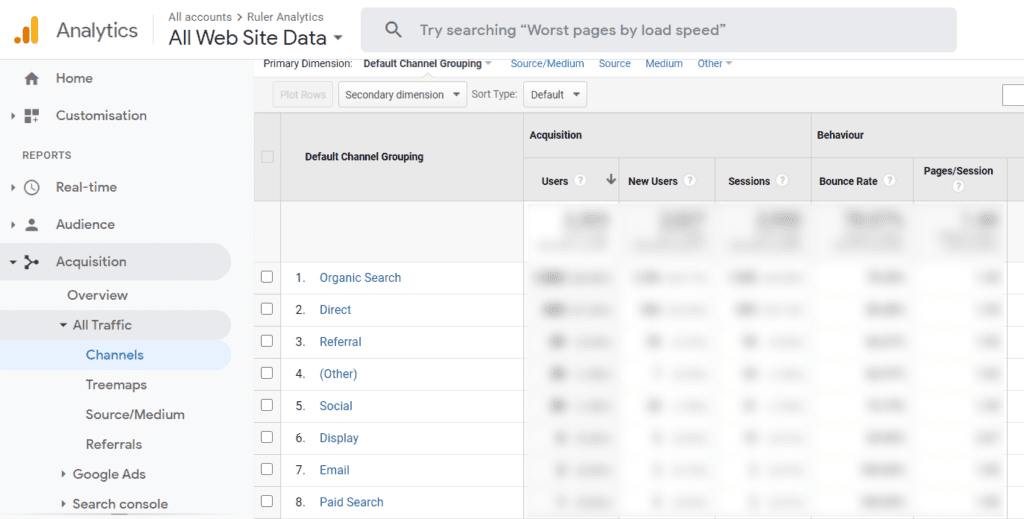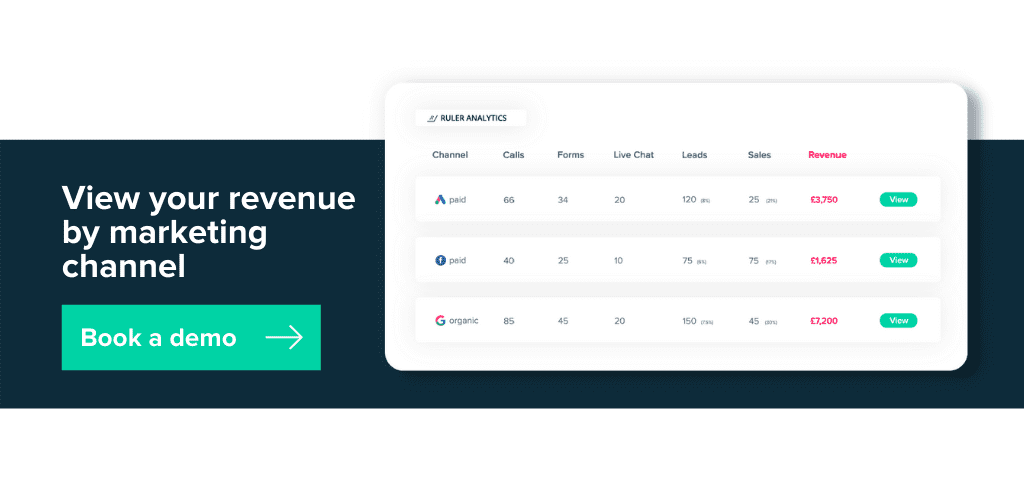Are you looking for ways to measure your offline marketing campaigns? We walk you through why it can be tricky to track some aspects of your marketing and how to get around it.
We’re deep in the digital age, but ‘old school’ methods of marketing haven’t gone away.
TV, print and press are all still great ways to get your company in front of mind.
In this blog, we’ll go through:
So, let’s get stuck in.
Marketing analytics tools like Google Analytics are an absolute must for any business looking to track the impact of their website.
It can help you understand how channels and campaigns drive sessions, clicks and more. But where it falls short is understanding the impact of your offline marketing.
Related: Limitations of Google Analytics
Campaigns on TV or in print or press can be hard to track.
In fact, we found that 100% of marketers using TV and radio for marketing struggled to track it. Meanwhile, 95% struggled to track print and 71% struggled to track press.
And it’s no surprise.
Ordinarily, Google Analytics could scrape the referring source so you can see how many sessions Facebook, Bing etc drove.
But with offline, you can’t source their session. Chances are, these users visit you directly or via organic branded searches.
Related: What are direct sessions in Google Analytics
And that means you can’t source your leads either.
⚡️ Pro Tip
It’s not just offline marketing that’s tricky to track. There’s the world of dark social that trips up marketers when it comes to tracking their leads and sales too. Read how we better understand the impact of brand marketing on our sales.
Learn about the impact of ‘how did you hear about us’ fields
So how do you better understand the impact of your offline marketing? Let’s find out.
Getting around these tracking issues isn’t easy, but it is possible.
By getting a full view of the impact of your offline marketing, you can ensure that key marketing metrics like ROAS and ROI are properly accounted for.
Keep reading to learn more about these 6 main ways to track offline marketing campaigns:
The easiest way to track the success of an offline marketing campaign is to use a marketing attribution tool.
Tools like Ruler Analytics will automatically track new leads, their customer journeys and then attribute their revenue when they close into a sale.
This includes offline marketing channels like TV, print, radio and offline sales methods like calls. With Ruler, you can track it all.
📈 Pro Tip
Not sure what attribution is or how it works? Read our complete guide to marketing attribution to better understand how it can link offline actions to online sales.
Or, check out exactly how Ruler attributes revenue back to your marketing.
One other way to track an offline marketing campaign is to use a custom landing page.
Custom landing pages are easier to track, as you can assume the number of users is an accurate measurement of how many people have responded to your campaign.
This is also a great way to compare your offline marketing efforts. If you’re testing out a printed ad in a newspaper versus flyer hand outs, then use two different custom landing pages so you can track impact. Whichever gets more sessions has more success in driving users to your website.
✏️ Note
Remember, if you’re creating campaign landing pages, you likely don’t want them appearing on users’ online searches. Make sure you list them as non-index so only those with the URL can find them.
If you’re considering using custom landing pages, then check out these handy tips we follow.
When running an offline marketing campaign, you might not want to drive viewers to your website. You might want them to call directly.
But how can you differentiate an inbound call from your offline campaign from an inbound call generated from an organic search, for example?
Custom phone numbers, of course!
Just like custom landing pages and URLs, you can use custom phone numbers to measure offline marketing campaigns.
☎️ Pro Tip
Learn more about call tracking and why it’s vital if you’re driving users to your business phone number.
How to track phone calls in Google Analytics
Call tracking is pretty easy to get started with. Ruler will assign a number to a set campaign and track every time it is called. Not only that, but it will monitor that user and give you key information on how they engage with your website and content.
Plus, when that lead closes into a sale, you’ll be able to attribute it back to your offline marketing campaign.
A simple way to track offline campaigns is with discount codes. Simply name your discount after the channel and you’ll be able to view discount entries in your eCommerce analytics.
By calling discount codes, RADIO20 or DAILYMAIL10, you can specify exactly where a user has come from. But again, remember. Discount codes are easily passed around, so while they still indicate success, it doesn’t necessarily mean that many people saw your original advertisement. That’s the power of word of mouth marketing!

Another way to track success of offline marketing is via non-referral traffic.
Head to Google Analytics. In your dashboard, choose acquisition, and then channels in the side bar menu.
Here, you’ll be able to see a breakdown of your overall traffic by channel. There will be the usual suspects like organic, social and email. But there will also be direct traffic.

Select a timeline that begins with the date you began your offline marketing push, and assess the change of direct hits to your website.
It’s likely these people who entered your URL directly into their search bar found you via offline literature.
A more simple (but not so accurate way) of measuring your offline marketing campaigns is by assessing your brand searches.
Head to your Google Search Console and select your website property. Click ‘search traffic’ in the left sidebar. Then select ‘search analytics’ from the drop-down menu.
Choose your date range, specifying your custom date range. Remember, the start date should be when your offline marketing campaign began.
Then, click on the “Queries” radio button. Take a look at your top queries for that date range.
If you see your brand name, that means people typed it directly into the search bar. It’s likely that those people learned about your brand name from your offline marketing literature. But remember, this isn’t an accurate method of attributing success to offline marketing.
💡 Pro Tip
Want even more detail on offline marketing tracking? We wrote a tell-all guide that will help you track your campaigns end to end.
Learn more about offline conversion tracking.
Ok, so a lot of the tips above can help you link your online website sessions back to your offline marketing campaigns.
And with this data, plus the ability to then track calls and forms on site, you can link that data together.
💭 Pro Tip
Not sure how to track your inbound conversions? We can help. Read our guides to:
– Tracking form submissions
– Monitoring and recording inbound calls
– Tracking live chat conversations and conversions
Customer journeys are getting more and more complex. One user could see a PPC ad, then a TV ad. They could find you organically, then see you via social media.

How do you understand how each of those channels and campaigns worked together to drive that one particular user down the customer journey?
Well, marketing attribution allows you to combine your online and offline marketing data. It can be used as a single source of truth when analysing your campaigns.
Related: How Ruler can help you optimise your marketing strategy
Modern marketers are swamped with data.
With users engaging with more content across longer time frames, marketers will struggle to link those independent sessions to one particular user.
But, by using marketing attribution, they can take the hard work out of their data.
Related: How to make data-driven marketing decisions
Luckily, marketing attribution can cut through the noise and provide the data you want, where you need it.
⚡️ Pro Tip
Want to learn more about Ruler and how its attribution functionality supports marketers to optimise their campaigns and content?
Book a demo to see the data available in action
We’ve already talked about measuring offline marketing campaigns. But marketing attribution allows you to take it to the next level.
Yes, you can track campaign phone numbers to understand how many inbound calls your campaign has generated. But even better, marketing attribution allows you to continue to track those new leads.
So, even if they have two, or twenty-two touchpoints between your offline campaign and conversion, you can still attribute them back to your offline marketing.
Here’s how it works:

A user engages with your website. Ruler Analytics tracks their referrer.
As the user continues to engage with your content, Ruler will continue to harvest their marketing data.
When they convert into a lead (whether that’s by phone, email, live chat or form), Ruler will fire all of their marketing and lead data over to your CRM, or wherever you’re storing your leads.
Ruler will continue to track this user. At the point of sale, Ruler will scrape all the revenue data from the CRM and fire it into your marketing apps and tools.
There, you’ll be able to see the real revenue data against the marketing channels and campaigns that drove it.
Why is this useful? Well, it allows you to:
Attribution allows you to measure your true return on investment. It combines all of your online and offline marketing data with your lead and revenue data.
You’ll be able to get oversight on how much revenue marketing has generated in sales, and how much is in the pipeline.
Forget wishy-washy metrics like clicks and leads. With attribution in play, you can give senior leaders definitive proof on how you’re performing.
With this quick and effective tracking and reporting, you can make quick decisions about your strategy and test new initiatives easily.
Since you’ll be measuring your campaigns with the one metric that matters, revenue, you’ll be able to optimise your campaigns.
Now you know how many conversions, leads and sales each campaign and channel generates, you’ll have a better understanding of what’s working, and what isn’t.
This is key data any marketer needs to up their game.
Offline marketing campaigns are a great way to drive new business and traffic. But, without proper tracking, it’s useless.
Marketing attribution is the only way to get true visibility of what in your marketing arsenal is working to drive revenue. And from a business perspective, what more could you want?
Get started with marketing attribution by booking a short demo. Our team will walk you through the platform and how you can combine your online and offline marketing data.
